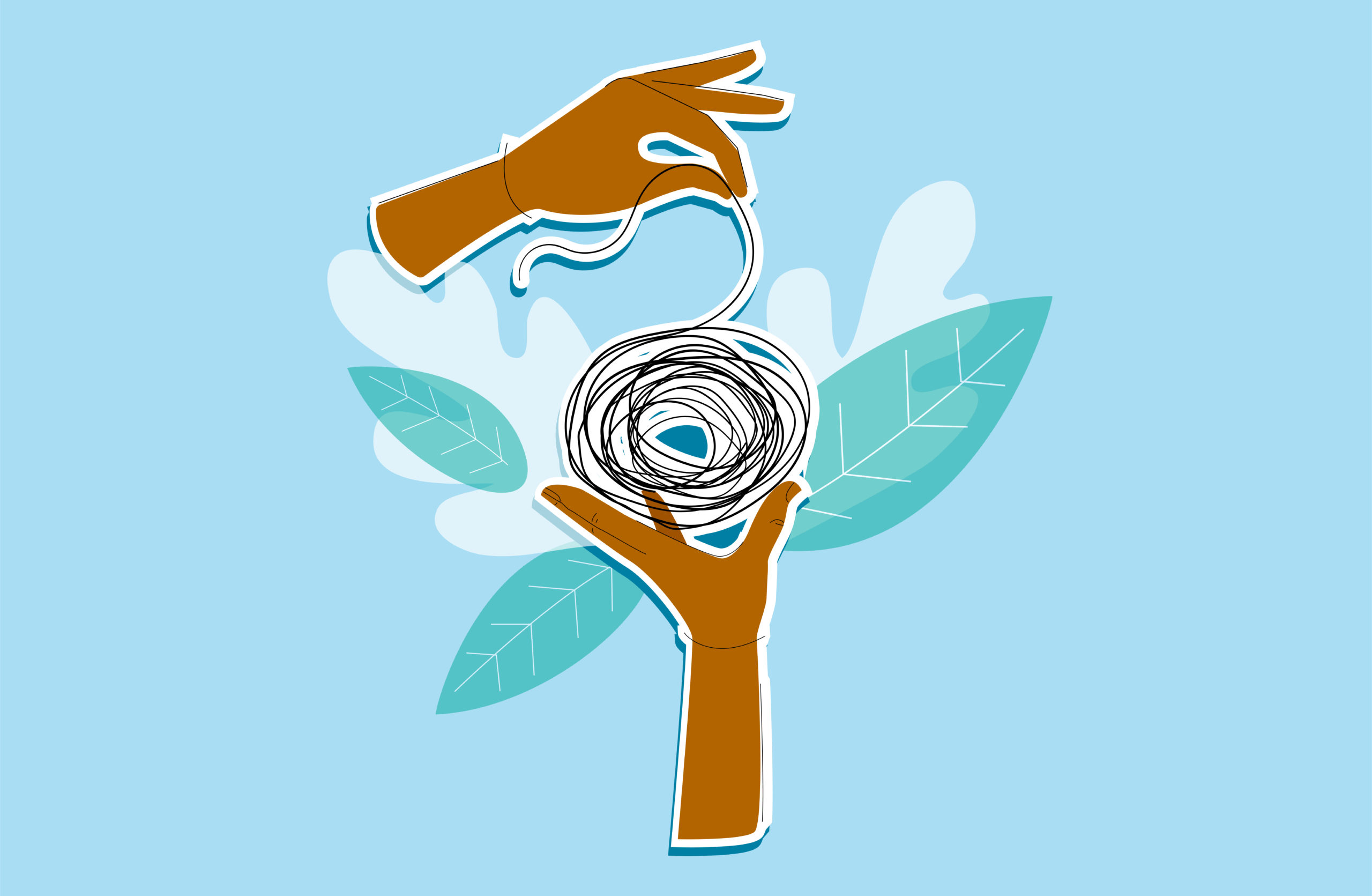Anxiety is not all bad. It can prompt us to take stock of our actions and life situation. It can give us a psychophysiological flick toward taking corrective, repairing action or artfully dodge oncoming peril. In these ways, a certain amount of anxious ants in our pants is helpful—it’s a major component of our in-the-moment motivation for healthy change.
The problem arises when anxiety overwhelms and blocks us. Traditional contemplative tradition refers to a pool of water (representing the mind), with anxious restlessness being the whipped up waters leading to muddiness, a lack of clear seeing to the bottom. When anxiety gets this wild inside us, we don’t see ourselves or the world accurately. We distort and react in order to stave off this internal chaos and we are hindered in our ability to relax into seeing clearly. We have a harder time focusing, and our efficiency in daily life takes a hit. Our brains juice up with the stress hormone cortisol in an ancient attempt to reduce threat, and we’re left feeling drained and depleted.
Anxiety is not all bad. It can prompt us to take stock of our actions and life situation. It can give us a psychophysiological flick toward taking corrective, repairing action or artfully dodge oncoming peril. The problem arises when anxiety overwhelms and blocks us.
Just Along for the Ride
Imagine yourself on a bus and you’re late for an important meeting. You’re taking a new route, there are a lot of stops, and the bus is overstuffed with people. You’re barely inching forward. Walking might get you there faster.
“How many more stops before mine?” You call up to the driver. He tells you not to worry, that your stop is only three more ahead. Yet you find your thoughts (and blood pressure) amping up even more when the driver waits for an elderly man to amble very slowly up to the bus.
“How much longer ’till we’re there?” you ask. “I can’t miss my meeting.”
This time, the driver just glances at you in his rear view mirror without saying anything.
The passenger next to you says, “we all have somewhere to be you know.”
Your thoughts race faster and your pulse is palpable at your temples. Sweat is making its way out in all the usual places.
And now imagine this bus is whatever “vehicle” you’re in during a given day that is not yours to drive, to control. It’s most every situation you’re in—the contexts where you are much more passenger than driver—and you’re just along for the ride.
How much does your increasing blood pressure and rush of thoughts actually move the “bus” any faster? Get you there any sooner?
And now imagine that you’re trying to meditate on this bus. Consider the all-too-common experience in meditation wherein you’re hoping to “get somewhere” with your sitting—to a happier, more satisfying life that will materialize before the session is over. Or maybe your meditation is a cacophony of monkey-on-methamphetamine thoughts and images. These are the sits when your eye pops open to check the clock, timer, or some evidence of sweet relief from the angst.
Rumination and The Inner Critic
Research is increasingly clear on how destructive anxious thinking can be. Rumination (or repetitive and passive thinking about negative emotions) has been shown to predict the chronic nature of depressive disorders as well as anxiety symptoms.
Rumination is the run-on self-talk of the mind that has physical and mental agitation as both its fuel and its output.
As a clinician, I’ve been trained to spot and address the unhealthy mental habit of repetitive and negatively-toned inner chatter that broils our minds and bodies from the inside. And it’s not just my patients who ruminate—it’s me (hypothetically, of course) telling myself over and over that I’m an “failure” as a father for texting during my son’s recital. Or eviscerating a future version of myself as a public speaker based on an open zipper incident while giving a talk last week. Rumination is the run-on self-talk of the mind that has physical and mental agitation as both its fuel and its output. Ruminative worry is toxic to our well-being and clarity of mind.
How to Approach to Anxious Thoughts
Research suggests part of the path forward relative to this aspect of anxiety. A 2010 study examined the levels of reported self-compassion, rumination, worry, anxiety and depression in 271 nonclinical undergraduate students. Results suggested that people with higher levels of reported self-compassion are less likely to report depression and anxiety. The data showed that self-compassion may play the role of buffering the effects of rumination. With mindfulness practice, we can learn how to unhook from rumination and cut ourselves (and others) the slack requisite for increasing clarity and ease of being.
It should be fairly obvious that when we’re not taking care of ourselves—when we’re not sleeping, eating, or moving our bodies adequately—this creates imbalances that contribute to anxiety. Similarly, when we behave unethically, these actions stir our minds and bodies with the muddy raw ingredients of anxiety. When our parents told us to “clean up our act” as teenagers (or as adults), they were not just making an off-hand swipe at our misdeeds, they were (perhaps unintentionally) taking aim at the very heart of our well-being.
Anxiety is the “check engine light” on our psychophysiological dashboard. It lets us know the system needs some balancing. Agitation is therefore not our enemy; ideally, we see it as a wake up call for mindfulness practice.
Mindful Breathing Practice for Anxiety
- Begin this practice by acknowledging the mere presence of anxiety—give a soft, slight internal nod to the thoughts, images, and sensations of worry and anticipatory angst.
- Rest in sensations of the breath. Let your attention drop gently onto wherever you feel feel the breath (e.g. nostrils, belly, or perhaps the toes for those more light on their feet).
- Penetrate the sense of anxiety in BOTH the body and mind on a deep inhale into the belly. Visualize the breath coming into and through the restlessness. The breath is not forcing the anxiety away, rather, it’s moving into it. Slow, deep belly breathing is important because anxiety often pulls us toward fast, chest-level breathing that actually sparks more physical sensations of anxiety.
Slow, deep belly breathing is important because anxiety often pulls us toward fast, chest-level breathing that actually sparks more physical sensations of anxiety.
- Acknowledge the anxiety just as it is on the exhale. Don’t try to shove the anxiety out with a sigh or exasperated puffing. Again, stay with slow, deliberate breathing. Note the sensations and word-images as if jousting with them using a feather.
- Continue following the breath, circulating between penetration into the space of awareness with the in-breath, acknowledging what remains on the exhale.
- Don’t force or control. Follow the anxiety just as it is, and simply penetrate through it with slow, deep breathing. Allow awareness to seep into and around these thoughts, sensations, and images.
- Take inventory of what remains after your allotted meditation time. What is there to be witnessed, felt, and acknowledged “behind” the anxiety? Take action to care for what needs tending.
read more
How I Stopped Terrorizing Myself
Mindful’s managing editor Stephanie Domet explores how choosing self-compassion in the face of things that go bump in the night, made for kinder days and easier nights.
Read More
Unwinding Your Anxiety Habit Loop
Coping with anxiety is difficult, but we can begin to untangle our anxious loops when we recognize how they show up in our daily activities.
Read More










